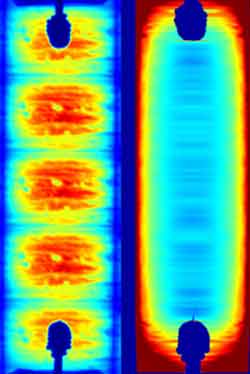X-rays shine light on high-intensity gas lamps

Scientists perform a series of calculations to transform X-ray intensity data (left, a montage of five separate images) into an image of the spatial distribution of mercury atoms in a high-intensity discharge lamp (right). Blue indicates the lowest density of atoms, red the highest.
An X-ray technique developed by physicists at the National Institute of Standards and Technology (NIST) is helping to improve the design and energy efficiency of the bright white lights often used to illuminate stadiums, roads and many other settings.
High-intensity gas discharge (HID) lamps produce 26 percent of the nation’s light output, but, as a result of their high energy efficiency, consume only 17 percent of the electricity used for lighting. Continuing improvements in energy efficiency and other features will reduce electricity use and the negative environmental effects of power generation. Improved efficiency could save lots of money: HID lamps consume roughly 4 percent of U.S. electricity, equivalent to about $10 billion annually.
The NIST technique uses X-ray imaging to improve understanding of the complex science underlying the HID lamp’s design. Such lamps have two electrodes in a ceramic tube that contains small amounts of mercury and metal-halide salts. An electric current between the electrodes heats the lamp, vaporizing the mercury and metal-halide salts and producing a gas of electrically charged particles, or plasma. Metal atoms, excited by collisions with electrons in the plasma, emit light at many different wavelengths, producing a bright, white light.
In the NIST technique, an HID lamp is placed in an intense beam of X-rays. The X-rays penetrate the lamp’s ceramic housing but are partially absorbed by the mercury gas in the lamp, casting a shadow in the beam. A special digital camera behind the lamp captures a high-resolution, two-dimensional image of this X-ray shadow showing the density of mercury atoms in the discharge. From the mercury distribution, the temperature distribution in the lamp also can be determined. This technique has been used to quantify processes that consume power without producing light.
Researchers now are demonstrating that this technique can be implemented in industrial laboratories using small-scale X-ray sources. This project provides measurement support to universities participating in the Advanced Light Source Research Program-II (ALITE-II) of the Electric Power Research Institute. The goals of the consortium are to make significant improvements in lighting technology by combining the resources of university, industry and government laboratories in pre-competitive research.
Media Contact
More Information:
http://www.nist.govAll latest news from the category: Physics and Astronomy
This area deals with the fundamental laws and building blocks of nature and how they interact, the properties and the behavior of matter, and research into space and time and their structures.
innovations-report provides in-depth reports and articles on subjects such as astrophysics, laser technologies, nuclear, quantum, particle and solid-state physics, nanotechnologies, planetary research and findings (Mars, Venus) and developments related to the Hubble Telescope.
Newest articles

A universal framework for spatial biology
SpatialData is a freely accessible tool to unify and integrate data from different omics technologies accounting for spatial information, which can provide holistic insights into health and disease. Biological processes…

How complex biological processes arise
A $20 million grant from the U.S. National Science Foundation (NSF) will support the establishment and operation of the National Synthesis Center for Emergence in the Molecular and Cellular Sciences (NCEMS) at…

Airborne single-photon lidar system achieves high-resolution 3D imaging
Compact, low-power system opens doors for photon-efficient drone and satellite-based environmental monitoring and mapping. Researchers have developed a compact and lightweight single-photon airborne lidar system that can acquire high-resolution 3D…





















